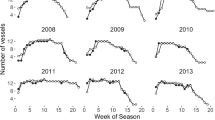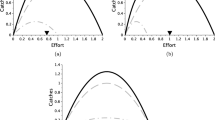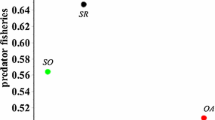Abstract
Fishers face multidimensional decisions: when to fish, what species to target, and how much gear to deploy. Most bioeconomic models assume single-species fisheries with perfectly elastic demand and focus on inter-seasonal dynamics. In real-world fisheries, vessels hold quotas for multiple species with heterogeneous biological and/or market conditions that vary intra-seasonally. We analyze within-season behavior in multispecies fisheries with individual fishing quotas, accounting for stock aggregations, capacity constraints, and downward-sloping demand. Numerical results demonstrate variation in harvest patterns. We specifically find: (1) harvests for species with downward-sloping demand tend to spread out; (2) spreading harvest of a high-value species can cause lower-value species to be harvested earlier in the season; and (3) harvest can be unresponsive or even respond negatively to biological aggregation when fishers balance incentives in multispecies settings. We test these using panel data from the Norwegian multispecies groundfish fishery and find evidence for all three. We extend the numerical model to account for transitions to management with individual fishing quotas in multispecies fisheries. We show that, under some circumstances, fishing seasons could contract or spread out.





Similar content being viewed by others
Notes
The multispecies context refers to a set of participants who target multiple fish species within a year, either sequentially or simultaneously, and typically under the same management plan and using the same gear. For example, cod, haddock, and saithe are often caught together in similar ocean environments and, in the Norwegian context, they are jointly managed under the same license defined by vessel and gear type even though the quotas are set on an individual species basis.
Although harvest can be fairly selective in multispecies fisheries—e.g., pelagics in the northeast Atlantic (Asche et al. 2007)—duality models are largely unable to distinguish between a fleet that targets a sequence of species in completely selective fisheries and a fleet in a non-selective fishery in which the share of each species is relatively constant within the year.
Smith et al. (2008) find evidence of effort substitution in response to spawning aggregations of gag (a species of grouper), but forward-looking behavior is not modeled explicitly.
In a model of species choice (Zhang and Smith 2011), the structure of the decision assumes one of three possible targets is chosen in each period and thus rules out the possibility of multispecies targeting. This feature largely reflects the general approach of discrete choice modeling. Some of the fine-scale empirical literature analyzes behavioral responses to changing stock abundance (Smith et al. 2008; Zhang 2011; Huang and Smith 2014).
Cod (Gadus morhua), haddock (Melanogrammus aeglefinus), and saithe (Pollachius virens) are also important species in the New England groundfish complex (saithe is commonly referred to as pollock but is a different species from the Alaskan walleye pollock, Gadus chalcogrammus).
We note three issues that our model does not address and that suggest future research directions: 1) strategic interactions and coordination failures among multiple IFQ holders; 2) within-season leasing and trading of IFQs; and 3) the complexities of an IFQ management regime co-existing with open access and regulated open access regimes that apply to other target fisheries.
The model described here produces the same results as a symmetric Nash equilibrium with Cournot competition as long as the aggregate industry-wide quota is set at a level that eliminates incentives of the fleet to withhold production from the market. This situation is highly relevant for our case study (Norwegian cod, haddock, and saithe), in which industry-wide quotas bind. Arguably, this situation also describes most fisheries; other explanations such as ecological co-occurrence and bycatch are typically offered when non-binding quotas occur at the industry level.
Equation (3) could be written as a more general demand model to allow market interactions between species, but we assume that species are neither substitutes nor complements. Since the species we model empirically are considered substitutes, incentives to concentrate harvest of one species with a relatively elastic demand would be moderated by positive cross-price elasticities with species having relatively less elastic demand.
The number of vessels, n, is fixed in the short term as we only analyze intra-seasonal behavior. Within the time period considered—a single fishing year—the fleet size is not expected to change. Over the longer term, profitability can motivate new participation, for example, when \(\alpha_{i} < 1\), if this is possible. However, in the Norwegian fleet, as in most managed fisheries, entry is limited.
This implicitly assumes that there is not a liquid rental market for fishing capacity, which is reasonable in most real-world settings. Such a market does not exist at all in many fisheries, and, as vessels need a license, it is a complicated and time-consuming process to be allowed to use a new vessel. Another setting where such a constraint has an impact is “high-grading,” which refers to throwing lower-value fish overboard because the hold capacity on each trip is limited (Vestergaard 1996).
When stock effects and discounting are removed and the production technology is otherwise constant returns (\(\alpha_{i} = 1\)), the harvest and effort paths are completely flat (Supplemental Figure 1).
Removing either discounting or the stock effect leads to the same result as long as the production technology is otherwise constant returns (\(\alpha_{i} = 1\)) (Supplemental Figure 2). With decreasing returns (\(\alpha_{i} < 1)\), the effort path reflects tradeoffs across concavity of the harvest function, which smooths effort, and discounting and the stock effect, which concentrate effort (Supplemental Figure 3).
This result is corroborated by Wakamatsu and Anderson (2018) in a single-species experimental game setting.
When stock effects and discounting are removed but the production technology is otherwise constant returns (\(\alpha_{i} = 1)\), the harvest path is perfectly flat and the effort path still has a dip during biological aggregation (Supplemental Figure 4).
For these parameters, this biological effect on catchability outweighs within-season discounting. Again, this is conditional on having no constraint on per-period effort capacity combined with constant returns to scale technology. Relaxing either of these assumptions induces some smoothing in catch and effort (Supplemental Figure 5).
We choose values for the constraints such that the tightest is an amount of capacity that does not allow the entire quota of the higher-value species to be caught, whereas the loosest is one that allows total quotas for both species to be caught flexibly. Effort can, for example, be interpreted as the number of weeks in a month that the fleet is out fishing.
To illustrate this, we consider a moderate capacity constraint (Emax= 3) and both 80-20 gear selectivity and 60-40 gear selectivity (Supplemental Figures 8 and 9).
The results are qualitatively similar when the two species’ biological aggregations are offset; the peaks and troughs in harvest patterns follow the biological patterns predictably (Supplemental Figure 6).
Note that with an even tighter effort constraint (Emax = 1), none of species 2 is taken, not all of species 1 quota is taken, and effort is allocated uniformly to species 1 (Supplemental Figure 7).
The three-species case explored in Fig. 4 is discussed in Appendix B. This provides an extension of the intuition for the two-species scenario.
The “trawl ladder” is a quota allocation instrument used in Norwegian fisheries that is based on historical rights. In an effort to keep the coastal fleet’s yearly catches stable, they are granted a larger part of the fishing quota in years with relatively moderate biomass. By comparison, the larger vessels such as trawlers have more fluctuating quota quantities.
Norwegian groundfish are targeted by a heterogeneous fleet broadly divided into coastal vessels, longliners, and trawlers.
Larsen and Dreyer (2012) indicate that under 20% of the total cod catch from trawlers is landed fresh. Almost all Norwegian-caught cod, regardless of product form, is exported.
The aggregate landings for the trawler fleet and the computed within-season variation are presented in Supplemental Table 1.
Supplemental Figure 13 shows average landings per month for the three sample years, focusing on the three IFQ species and normalizing each year to the average monthly landings in the year.
Although there is not a comparable analysis for Norway, Lee (2014) demonstrates that U.S. cod prices are responsive to quantity landed at a daily time step, and Gordon and Hannesson (1996) establish links between the U.S. and European cod markets. As such, it is reasonable to assume that the Norwegian cod prices are responsive to quantity landed at the monthly scale.
To illustrate the differences across species, we also plot the hazard rates (Supplemental Figure 14).
The topic of how incentives to target and associated behaviors change under institutional change in fisheries is of growing interest and has many complications (Abbott et al. 2015; Reimer et al. 2017). Our intention here is to illustrate how simple mechanisms in our model offer some possibilities for what to expect in multispecies fisheries.
Alternatively, one can think of this conceptual model as one in which quota is tradable but already efficiently allocated—that is, one in which a market equilibrium has been achieved following a period of trading.
References
Abbott JK, Wilen J (2011) Dissecting the tragedy: a spatial model of behavior in the commons. J Environ Econ Manag 62:386–401
Abbott JK, Haynie AC, Reimer MN (2015) Hidden flexibility: institutions, incentives, and the margins of selectivity in fishing. Land Econ 91(1):169–195
Amigues JP, Favard P, Gaudet G, Moreaux M (1998) On the optimal order of natural resource use when the capacity of the inexhaustible substitute is limited. J Econ Theory 80(1):153–170
Årland K, Bjørndal T (2002) Fisheries management in Norway. Mar Policy 26:307–313
Arnason R, Sandal LK, Steinshamn SI, Vestergaard N (2004) Optimal feedback controls: comparative evaluation of the cod fisheries in Denmark, Iceland, and Norway. Am J Agric Econ 86(2):531–542
Asche F (2009) Adjustment cost and supply response: a dynamic revenue function. Land Econ 85(1):201–215
Asche F, Zhang D (2013) Testing structural changes in the U.S. Whitefish import market: an inverse demand system approach. Agric Resour Econ Rev 42(3):453–470
Asche F, Flaaten O, Isaksen JR, Vassdal T (2002a) Derived demand and relationships between prices at different levels in the value chain: a note. J Agric Econ 53(1):101–107
Asche F, Gordon DV, Hannesson R (2002b) Searching for price parity in the European Whitefish market. Appl Econ 34(8):1017–1024
Asche F, Gordon DV, Jensen CL (2007) Individual vessel quotas and increased fishing pressure on unregulated species. Land Econ 83:41–49
Asche F, Bjørndal T, Gordon DV (2009) Resource rent in individual quota fisheries. Land Econ 85(2):279–291
Asche F, Bjøndal MT, Bjørndal T (2014) Development in fleet fishing capacity in rights based fisheries. Mar Policy 44:166–171
Bergstad OA, Jørgensen T, Drangesund O (1987) Life history and ecology of the gadoid resources of the Barents Sea. Fish Res 5:119–161
Birkenbach AM, Kaczan D, Smith MD (2017) Catch shares slow the race to fish. Nature 544(7649):223–226
Boyce JR (1992) Individual transferable quotas and production externalities in a fishery. Nat Resour Model 6(4):385–408
Chakravorty U, Krulce DL (1994) Heterogeneous demand and order of resource extraction. Econometrica 62(6):1445–1452
Clark CW (1980) Towards a predictive model for the economic regulation of commercial fisheries. Can J Fish Aquat Sci 37(7):1111–1129
Cojocaru A, Asche F, Pincinato RB, Straume H-M (2019) Where are the fish landed? An analysis of landing plants in Norway. Land Econ 95(2):246–257
Cunningham S, Bennear LS, Smith MD (2016) Spillovers in regional fisheries management: do catch shares cause leakage? Land Econ 92(2):262–344
Das C (2013) Northeast trip cost data—overview, estimation, and predictions. NOAA Technical Memorandum NMFS-NE-227. https://www.nefsc.noaa.gov/publications/tm/tm227/tm227.pdf. Accessed 15 Aug 2019
Eggert H, Tveteras R (2004) Stochastic production and heterogeneous risk preferences: commercial fishers’ gear choices. Am J Agric Econ 86:199–212
Fell H (2009) Ex-vessel pricing and IFQs: a strategic approach. Mar Resour Econ 24(4):311–328
Gordon DV, Hannesson R (1996) On prices of fresh and frozen cod. Mar Resour Econ 11:223–238
Grafton RQ, Squires D, Fox KJ (2000) Private property and economic efficiency: a study of a common-pool resource. J Law Econ 43(2):679–714
Guttormsen AG, Roll KH (2011) Technical efficiency in a heterogeneous fishery. Mar Resour Econ 26(4):293–308
Hammarlund C (2015) The big, the bad, and the average: hedonic prices and inverse demand for Baltic cod. Mar Resour Econ 30(2):157–177
Hannesson R, Salvanes KG, Squires D (2010) Technological change and the tragedy of the commons: the Lofoten fishery over 130 years. Land Econ 86(4):746–765
Herfindahl OC (1967) Depletion and economic theory. In: Gaffney M (ed) Extractive resources and taxation. University of Wisconsin Press, Madison, WI, pp 63–90
Hicks RL, Schnier KE (2008) Eco-labeling and dolphin avoidance: a dynamic model of tuna fishing in the Eastern Tropical Pacific. J Environ Econ Manag 56:103–116
Holland D, Sutinen JG (2000) Location Choice in the New England trawl fisheries: old habits die hard. Land Econ 76:133–149
Homans FR, Wilen JE (1997) A model of regulated open access resource use. J Environ Econ Manag 32:1–21
Homans FR, Wilen JE (2005) Markets and rent dissipation in regulated open access fisheries. J Environ Econ Manag 49:381–404
Huang L, Smith MD (2014) The dynamic efficiency costs of common-pool resource exploitation. Am Econ Rev 104(12):4071–4103
Hutniczak B (2014) Increasing pressure on unregulated species due to changes in Individual Vessel Quotas: an empirical application to trawler fishing in the Baltic Sea. Mar Resour Econ 29(3):201–217
Kroetz K, Sanchirico JN, Lew DK (2015) Efficiency costs of social objectives in tradable permit programs. J Assoc Environ Resour Econ 2(3):339–366
Kvamsdal SF (2016) Technical change as a stochastic trend in a fisheries model. Mar Resour Econ 31(4):403–419
Larkin SL, Sylvia G (1999) Intrinsic fish characteristics and intraseason production efficiency: a management-level bioeconomic analysis of a commercial fishery. Am J Agric Econ 81:29–43
Larsen TA, Dreyer B (2012) Norske torsketrålere—Struktur og lønnsomhet (from Norwegian: Norwegian cod trawlers—fleet structure and profitability). Nofima Report. https://nofima.no/en/pub/1073592/
Lee M-Y (2014) Hedonic pricing of Atlantic cod: effects of size, freshness, and gear. Mar Resour Econ 29(3):259–277
Lee M-Y, Thunberg EM (2013) An Inverse demand system for New England groundfish: welfare analysis of the transition to catch share management. Am J Agric Econ 95(5):1178–1195
Lewis TR (1982) Sufficient conditions for extracting least cost resource first. Econometrica 50:1081–1083
NOU 2016: 26 (2016) Et Fremtidsrettet Kvotesystem (from Norwegian: a quota system for the future). Ministry of Trade, Industry and Fisheries, Oslo
NSC (2018) How effectively does the Norwegian seafood council promote Norwegian Whitefish exports. Research Report to the Norwegian Seafood Council, June 2018, Tromsø, Norway
Reed WJ (1979) Optimal escapement levels in stochastic and deterministic harvesting models. J Environ Econ Manag 6(4):50–363
Reimer MN, Abbott JK, Haynie AC (2017) Empirical models of fisheries production: conflating technology with incentives? Mar Resour Econ 32(2):169–190
Shumway CR, Pope RD, Nash EK (1984) Allocatable fixed inputs and jointness in agricultural production: implications for economic modeling. Am J Agric Econ 66(February):72–78
Singh K, Dey MM, Surathkal P (2012) Analysis of a demand system for unbreaded frozen seafood in the United States using store-level scanner data. Mar Resour Econ 27(4):371–387
Skonhoft A, Vestergaard N, Quaas M (2012) Optimal harvest in an age structured model with different fishing selectivity. Environ Resour Econ 51:525–544
Smith VL (1969) On models of commercial fishing. J Political Econ 77:181–198
Smith MD (2012) The new fisheries economics: incentives across many margins. Annu Rev Resour Econ 4:379–402
Smith MD, Wilen JE (2005) Heterogeneous and correlated risk preferences in commercial fishermen: the perfect storm dilemma. J Risk Uncertain 31:53–71
Smith MD, Zhang J, Coleman FC (2008) Econometric modeling of fisheries with complex life histories: avoiding biological management failures. J Environ Econ Manag 55:265–280
Solow RM, Wan FY (1976) Extraction costs in the theory of exhaustible resources. Bell J Econ 7:359–370
Squires D (1987) Long-run profit functions for multiproduct firms. Am J Agric Econ 69:558–569
Squires D, Kirkley JE (1991) Production quota in multiproduct Pacific fisheries. J Environ Econ Manag 21:109–126
SSB (2019) Statistics Norway. https://www.ssb.no/en/fiskeri. Accessed 18 July 2019
Stafford T (2018) Accounting for outside options in discrete choice models: an application to commercial fishing effort. J Environ Econ Manag 88:159–179
Valcu A, Weninger Q (2013) Markov-perfect rent dissipation in rights-based fisheries. Mar Resour Econ 28(2):111–131
Vestergaard N (1996) Discard behavior, highgrading and regulation: the case of the Greenland shrimp fishery. Mar Resour Econ 11(4):247–266
Wakamatsu M, Anderson CM (2018) The endogenous evolution of common property management systems. Ecol Econ 154:211–217
Weninger Q, Waters JR (2003) Economic benefits of management reform in the Northern Gulf of Mexico reef fish fishery. J Environ Econ Manag 46:207–230
Zhang J (2011) Behavioral response to stock abundance in exploiting common-pool resources. BE J Econ Anal Policy. https://doi.org/10.2202/1935-1682.2856
Zhang J, Smith MD (2011) Heterogeneous response to marine reserve formation: a sorting model approach. Environ Resour Econ 49:311–325
Acknowledgements
The authors thank the Research Council of Norway and the Knobloch Family Foundation for financial support of this research.
Author information
Authors and Affiliations
Corresponding author
Additional information
Publisher's Note
Springer Nature remains neutral with regard to jurisdictional claims in published maps and institutional affiliations.
Electronic Supplementary Material
Below is the link to the electronic supplementary material.
Rights and permissions
About this article
Cite this article
Birkenbach, A.M., Cojocaru, A.L., Asche, F. et al. Seasonal Harvest Patterns in Multispecies Fisheries. Environ Resource Econ 75, 631–655 (2020). https://doi.org/10.1007/s10640-020-00402-7
Accepted:
Published:
Issue Date:
DOI: https://doi.org/10.1007/s10640-020-00402-7
Keywords
- Multispecies fishery
- Multi-fishery
- Sequential fishery
- Fishing behavior
- Seasonal harvest
- Catch shares
- Seafood demand




